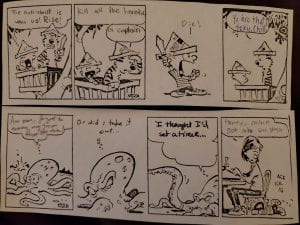My appropriation game has four players using four panel comic strips in a ‘New York Times’ caption contest/exquisite corpse mashup. The materials are simple: each player requires only a writing utensil, and comic strips are provided with the text blanked out. Each player begins with a single strip, filling in the missing text of the first panel with anything they want. The strips are then passed around the table and the process is repeated four times at which point the strips will be complete with text.

The game draws heavy inspiration of course from exquisite corpse–although each player is able to see all of the panels and what has already been written, the prompt was naturally open-ended enough to create a similar feeling of freedom and creative liberty. I felt that allowing players to work with this continuity was an integral part of creating the experience I was after; some of my favorite strips produced in playtesting are displayed in this post. However, in true exquisite corpsian fashion the setup certainly didn’t deter some truly baffling strips more akin to Hugo Ball’s nonsense poetry than anything else.
After reading ‘The Well-Played Game’, I was also determined going into this project to rethink the competitive experience I was creating. It was hugely important to me that this game played in more of a couch co-op style where elements of challenge still exist, but the players are in direct collaboration in facing those challenges together. There is no winner, only a series of funny strips everyone was involved in creating.

I manufactured the blank strips by photocopying them out of treasury compilations, and later editing them digitally to remove the text. In the first iteration of the game, they were all from ‘Calvin and Hobbes’ (a personal favorite), but the game was later expanded to include strips from other treasuries I had on hand: ‘Peanuts’, ‘Pearls Before Swine’, and ‘The Adventures of Tintin’.
The inclusion of ‘Tintin’ was based on a recommendation by our guest playtester, who suggested I appropriate potentially controversial material in order to transform it–notorious for problematic representations of people of color, ‘Tintin’ seemed like a good choice to test this out. It raised some eyebrows in playtesting, but didn’t have a significant enough impact to warrant keeping it in the final game.
